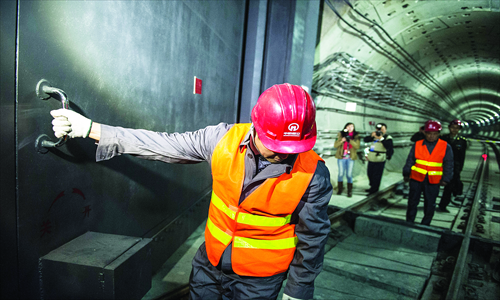City’s subway safe from gas, nuclear attack

Beijing's newly completed subway lines and stations can withstand a nuclear or poison gas attack, civil defense authorities said Tuesday.
Testing and inspection of the first phase of Subway Line 6, and the second phases of Lines 8, 9 and 10 are complete. The lines are expected to open on December 28, Beijing Civil Defense Bureau announced at a conference Tuesday.
The new subway lines have been designed to be used in the event of an emergency, for underground evacuation from one station to another, emergency shelter and storage for emergency supplies.
An engineer from the Engineering Design & Research Institute of the Second Artillery Corps, surnamed Hu, told the Global Times she helped design the civil defense infrastructure in the subway system.
For instance, the special gates that are installed in each tunnel, which separate a station and part of the tunnel, are designed to protect those who shelter inside when the city encounters a heavy storm, toxic gas, or even a nuclear attack, said Hu.
"The station has three hours of breathable air after the gates are closed, isolating the station from the outside world," said Hu, although she did not say how many people this oxygen supply could sustain.
The steel doors are installed in the tunnels and can separate each station.
"Although each gate weighs around 7 tons, it takes just three minutes for two adults to open or close it manually," she said.
"This new technical gate was introduced into subway construction projects since Subway Line 5 in 2007," said Hu, noting that compared to the previous gates, the new ones are easier to manipulate and maintain.
Another colleague of Hu, surnamed Liang, told the Global Times that each station does have an air filtration system in case of gas attack, and it will also keep air flowing into the station.
"People can actually shelter in the subway for more than three hours because of this system," said Liang.
The above-ground subway exits can also be sealed off in the event of an attack, said Liang, as there are also heavy doors concealed behind a temporary wall, which can easily be removed.
English tutor Zhao Zhenliang, who often commutes by subway, said this is the first time he has heard about this civil defense infrastructure.
"It sounds quite cool to me, but what's the use of hiding in the subway if there's a nuclear attack?" he said.
"But generally speaking, having more shelters in town is always better," he said, "it will make residents feel safer to some extent."
Cao Yanping, deputy director of the supervision office of the Beijing Municipal Civil Air-Raid Shelter, said at the conference Tuesday that it has been a difficult project to install all the new infrastructure.
"Some civil defense infrastructure in the Beijing Subway will be installed later after the subway lines are opened this year because of various reasons," he said, although he did not specify what these are.
The gates have been installed in other subway systems in China.
Jiang Hao, an engineer from the 4th Engineer Design & Research Institute of General Staff Department, said that the gates for civil defense have already been used in the subway in cities like Nanjing in Jiangsu Province and Shenyang in Liaoning Province.
"The new facilities also have other defensive capabilities like emergency communication equipment at each station, which makes effective communication possible during a conflict," Jiang said at the conference.
Although subway systems in China have not been subject to terrorist attack or other emergencies, subways in other countries have been attacked.
In Tokyo in 1995, an attack by the Japanese Aum Shinrikyo cult killed 13 and sickened 6,300, after the highly toxic sarin nerve gas was released into the subway at rush hour, reported the Japan Times in 2010.
On July 7, 2005, terrorists set off bombs on three London underground lines and one on a public bus, killing 52 and injuring over 700 commuters, according to the BBC in July, 2005.